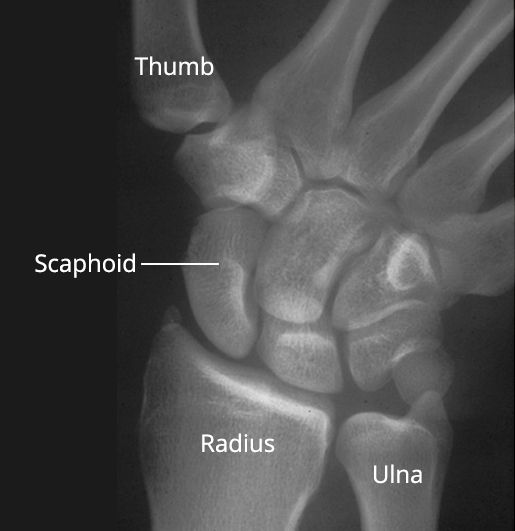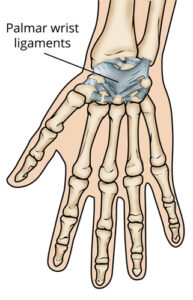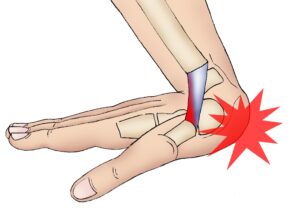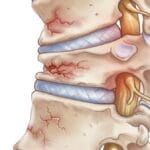Rephrased Paragraph:
A wrist sprain happens when the resilient ligaments supporting the wrist are overstretched or torn. This typically results from a forceful bend or twist, often caused by falling onto an outstretched hand. Wrist sprains are frequent injuries that vary in severity, depending on the extent of ligament damage
Ligaments support the wrist by linking the bones that make up the joint.
Description
Ligaments are tough, fibrous tissues that link bones together, playing a crucial role in keeping wrist bones aligned and ensuring joint stability.
Wrist sprains can range from a simple stretch or minor tear in the ligament’s fibers to a complete rupture, either through the ligament itself or at its attachment point on the bone.
Grades of Wrist Sprains
The severity of wrist sprains is categorized based on the extent of ligament injury:
- Grade 1 sprain (mild): The ligaments are stretched but remain intact.
- Grade 2 sprain (moderate): The ligaments are partially torn, which may lead to a reduction in wrist function.
- Grade 3 sprain (severe): The ligament is fully torn or detached from its bone attachment. These severe injuries often require medical or surgical treatment. If the ligament pulls away a piece of bone along with it, this is known as an avulsion fracture.
Causes
Wrist sprains are most commonly the result of falling onto an outstretched hand, which can happen during daily activities but is particularly common in sports and outdoor activities.
You may sprain your wrist if you fall onto an outstretched hand.
Symptoms
A sprained wrist typically causes pain. Additional symptoms may include:
- Swelling
- Bruising
- Tenderness when touched
- A sensation of popping or tearing within the wrist
- A feeling of warmth around the wrist
Even a wrist injury with minimal swelling could involve a torn ligament that may necessitate surgery to prevent future complications.
Similarly, an unnoticed (occult) fracture can sometimes be mistaken for a mild or moderate sprain. If untreated, such a fracture may not heal correctly, potentially requiring surgery that early intervention could have prevented. One common example is an occult fracture of the scaphoid, a small wrist bone.
If a wrist injury shows persistent pain or fails to improve quickly, it is essential for a doctor to evaluate it. Accurate diagnosis and appropriate treatment of wrist injuries are crucial to avoiding long-term issues, including chronic pain, stiffness, and arthritis
An unrecognized fracture of the scaphoid bone may be mistaken for a wrist sprain.
Doctor Examination
Physical Examination
During your consultation, your doctor will review your medical history and overall health, focusing on any previous injuries to your hand or wrist. They will ask about how and when your current injury occurred and will inquire about your symptoms, including any numbness in your hand or pain in other areas.
Your doctor will then carefully examine your wrist to identify points of tenderness and assess its range of motion. Pain in specific areas might also indicate a bone fracture. A full examination of your hand and arm will follow to rule out any additional injuries.
Imaging Tests
To aid in diagnosis, your doctor may recommend imaging tests.
- X-rays: Although x-rays do not display ligaments, they can reveal ligament damage if the wrist bones appear misaligned. X-rays also help rule out fractures in the wrist.
- Additional Tests: If further detail is needed, a magnetic resonance imaging (MRI) scan, computerized tomography (CT) scan, or an arthrogram may be ordered. In an arthrogram, a special dye is injected into the wrist joint to enhance joint and ligament visibility in imaging studies.
Treatment
The treatment plan for a wrist sprain depends on the injury’s severity.
Home Care
Mild wrist sprains often respond well to home care using the RICE protocol:
- Rest: Avoid using the wrist for at least 48 hours.
- Ice: Apply ice right after the injury to control swelling. Use cold packs for 20 minutes at a time, multiple times daily. Avoid applying ice directly to the skin.
- Compression: An elastic compression bandage can help limit swelling.
- Elevation: Elevate your wrist above heart level as much as possible.
Additionally, nonsteroidal anti-inflammatory drugs (NSAIDs), such as aspirin or ibuprofen, may help relieve pain and reduce swelling. If symptoms persist beyond 48 hours, consult a doctor.
Nonsurgical Treatment
Moderate sprains may require immobilization with a wrist splint for a week or longer. To counteract stiffness from immobilization, your doctor might recommend specific stretching exercises to restore full range of motion in your wrist.
This rephrasing maintains scientific accuracy while incorporating SEO-friendly keywords such as “wrist sprain treatment,” “imaging tests for wrist injuries,” and “RICE protocol for wrist sprains.
A wrist splint.
Thinkstock © 2016
Surgical Treatment
For severe wrist sprains, surgery may be necessary to repair a completely torn ligament. Surgical repair typically involves either reattaching the ligament to the bone or reconstructing it using a tendon graft. Your doctor will discuss the most suitable option for your specific case.
Post-surgery, a rehabilitation program is essential to help restore wrist strength and mobility. While the ligament often heals within 8 to 12 weeks, full recovery can take 6 to 12 months, depending on the injury’s severity and your individual healing process.
Prevention
Since wrist sprains often occur from falls, it’s important to exercise caution on wet or slippery surfaces. Sports like skating, skateboarding, and skiing also carry a risk of wrist sprains. Wearing wrist guards or protective taping during these activities can provide additional wrist support and help prevent excessive backward bending in the event of a fall.
This version keeps the technical details intact and is optimized for SEO with keywords like “severe wrist sprain surgery,” “rehabilitation for wrist injuries,” and “wrist sprain prevention tips.”









